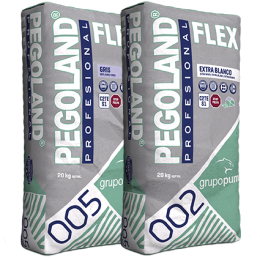 Pegoland® Profesional Flex C2 TE S1
Pegoland® Profesional Flex C2 TE S1

Cementitious adhesive made with mixed bonding agents, with low dust emission, low VOC emissions and great whiteness high flexibility and bonding strength, non slip and extended open time. Suitable for exterior and interior pavements and claddings.
Particularly suitable for bonding façades, large flooring areas and floors with underfloor heating. Suitable for plaster or anhydrite substrates.
Additional information
Composition
Product based on high resistance cement, selected aggregates, Synthetic resins, special fibers and the latest technology additives that guarantee a high bonding strength, workability and resistance to ageing.
Features and applications
- Excellent workability and great whiteness.
- Rheologically improved with high stability and excellent performance.
- Creamy texture, high thixotropy.
- Technologically advanced, compatible with a large variety of substrates.
- Stable in a wide range of mixing methods.
- High thixotropic efficiency, improved convenience and lesser effort.
- Product that prevents the suspension of dust particles in the environment.
- Suitable for both indoor and outdoor applications. Façades.
- Low VOC emission
- Bonds to all sorts of ceramic tiles, porcelain, marble, granite and natural stone.
- Fixing of tiles over cementitious waterproofing from MORCEMDRY range of products.
- Avoids having to dampen the tiles or substrates thanks to its high water retaining performance.
- Can be applied in thicknesses up to 15 mm.
- High resistance to sagging. Excellent initial adhesion.
- Extended open time, allows for the repositioning of tiles.
- Deformable. Type S1. Complies with standard UNE EN 12002.
- High wetting capacity.
- Adhesion of large format pieces.
- Bonding of large surfaces with heavy traffic, floors with under floor heating, refrigerated chambers and overlays.
- Swimming pool coverings. Suitable for immersion.
Substrates
- Conventional cement-based, plaster or anhydrite substrates without priming being required.
- Over any type of plasterboard laminate partitioning (PBL), large format clay brick, concrete, cellular concrete, fibre-cement, plasterbricks, mortars and self-levelling pastes,
- Floor coverings such as marble, granite, terrazzo, natural stone and all types of tiles.
- Substrates must be resistant, stable, sound and clean, free of dust, demolding agents, organic products, etc.
- Do not apply on painted surfaces.
- All substrates must have the appropriate flatness (maximum deviation tolerance of ±3 mm measured under a 2 metre ruler). If not, a screed should be made using the same product up to a maximum of 5 mm at least 48 hours prior to bonding. For a larger thickness use:
- On screeds: NIVELAND 10R or PAVILAND RECRECIDO AUTONIVELANTE, according to substrate and requirements.
- On facings: levelling mortars with appropriate tensile strength and curing retraction already finished.
- In case of hot or windy weather conditions or when applying over absorbent substrates, it is advisable to wet the substrate and wait till the thin layer of water disappears.
- In exterior pavements, the support must have a slope equal or more than 1%.
Instructions for use
- Add water 26-31% (approx. 5,2-6,2 liters per 20 kg bag) and mix by hand or mechanically until it takes on an even and workable consistency.
- Let the mixture stand for 5 minutes and remix.
- Spread the mixed product on the substrate with a trowel to a maximum surface area of 2 m2.
- Spread with a notched trowel to adjust the thickness (see chart).
- Place the pieces on the fresh adhesive, pressing and moving until the grooves are completely crushed and the entire surface of the ceramic is properly adhered, periodically check the stickiness of the adhesive by lifting a previously laid tile, if a non-transfer film appears on the surface of the adhesive, or dehydration of the adhesive, proceed to remove the material and apply a new product.
- Laying the tiles by a double glueing method outdoors, for formats greater than 900cm2, on floors of commercial or industrial use, if there is underfloor heating, when laying ceramic sheets, if using levelling systems or if the tiles have a relief such as that good contact with the adhesive is difficult.
- Respect the construction joints (expansion, contraction, sealing, corner joints) and placing between bricks (minimum 2 mm inside and 5 mm outside).
- Joints should be grouted 24 hours after laying on vertical surfaces, and 48 hours after on floors. Use the appropriate mortar from MORCEMCOLOR range of products, according to the grouting requirements.
PLEASE NOTE: for better results lay tiles as soon as possible after spreading.
Cautions and recommendations
- Do not apply under 5ºC or above 30ºC.
- Do not apply when there is a risk of frost, rain, strong wind or direct sunlight.
- Never apply with the technique known as " by spots ".
- The manageability and setting times of the adhesive can vary according to the temperatures, ventilation, substrate absorbency and covering materials used.
- In extreme weather conditions (strong winds or hot temperatures) drying may occur faster than normal.
- On floor coverings and facings with a surface area greater than 50 m2 for interiors and 30 m2 for exteriors, or for elongated areas over 15 lineal metres it is recommended to leave separation or sealing joints filled with a deformable material (PUMALASTIC range of products).
- It is advisable to keep a free perimeter expansion joint between the floor and the wall or pillar, hidden by a skirting board (of approximately 5 mm). These joints should be sealed with a deformable material (PUMALASTIC range of products).
- On floors with radiant heating, apply when the surface is at room temperature (between 5ºC and 30ºC)
- Underfloor heating systems should be switched off at least 48 hours prior to use and should be switched back on again gradually at least 7 days after installing the flooring and pointing operation.
- When using on plasterboard, ensure the substrate is fixed well to avoid any movement.
- For use on cooling chambers, these should remain switched off until the correct adhesive curing has been obtained, at least 7 days depending on ambient conditions.
- Swimming pools can be refilled 7 days after applying the adhesive.
- The water-tightness of a swimming pool must be ensured before using the product on it.
- For elements reinforced with fibreglass meshing on the back, please consult our technical department.
- For slate use PEGOLAND® PROFESSIONAL FLEX ELITE C2 TE S2 or PEGOLAND® FLEX RECORD.
- Anhydrite screeds must be completely dry (maximum residual humidity 0, 5%), hard enough and free from any superficial dust or grout, which must be eliminated by sanding.
- On ceramic floors (overlapping), remove the pieces that are badly adhered and fill the gaps with mortar the day before applying the product. Ensure that the old ceramic is free of grease or wax residues, if necessary proceed to the milling of the glazed surface until the loss of brightness of the old ceramic. In case of doubt to make previous test to establish the suitability of the contributed solution.
- When working with tiles that can be stained due to their high water absorption should be placed with fast-setting adhesives. Use PEGOLAND FAST FLEX C2FTE S1.
Packaging
20 kg plastic-lined paper bags.
Shelf life: 1 year in sealed original packaging, sheltered from weather conditions and humidity.
Technical data
(Statistical data obtained under standard conditions)
| Appearance | WHITE powder and GREY |
| Adjustment time | Approx. 30 mins (depending on weather conditions) |
| Paste open time | Approx. 2 hours (depending on weather conditions) |
| Initial adhesion | ≥ 1 N/mm² |
| Adhesion after water immersion | ≥ 1 N/mm² |
| Adhesion after heat ageing | ≥ 1 N/mm² |
| Adhesion after freeze/thaw cycles | ≥ 1 N/mm² |
| Temperatura de serviço | -30ºC a 90ºC |
| Classified according to UNE EN 12004:2008: | C2TE |
| Classified according to UNE EN 12002:2009: | S1 |
| Approximate performance | Colagem simples: 4 kg/m2 |
| Colagem dupla: 6 kg/m2 |
Environmental Product Declaration (EPD)
Cement based mortar prepared with aggregates that are supplied close to the production center, which reduces the greenhouse gas emissions that would otherwise arise from their transport. Manufactured in production centers with an Environmental management certified system following ISO 14001 regulation, offering a firm promise of sustainability and respect for the environment.
Cement based mortar with type III ecological label (the most strict) Environmental Product Declaration verified externally by AENOR.
Note
GRUPO PUMA is not responsible, in any case, for the application of its products or constructive solutions carried out by the application company or other parties involved in the process and / or execution of the work, limiting the responsibility of GRUPO PUMA exclusively to the damages directly attributable to the supplied products, individually or integrated in systems, due to failures in their manufacturing process.
In any case, the drafter of the work project, the technical management or the person responsible for the work, or collaterally the application company or other parties involved in the process and / or execution of the work, must ensure the suitability of the products addressing the characteristics of them, as well as the conditions, support and possible pathologies of the work in question.
The values obtained by GRUPO PUMAS's products or its constructive solutions that, as the case may be, are determined by the EN standards or any other regulation that applies to it in each case refers exclusively to the conditions specifically stipulated in said regulation and that are referred to, among others, to certain characteristics of the support, humidity and temperature conditions, etc. without being them required in the tests obtained under different conditions, all in accordance with the relevant regulation.